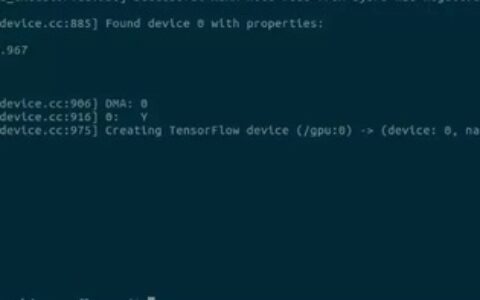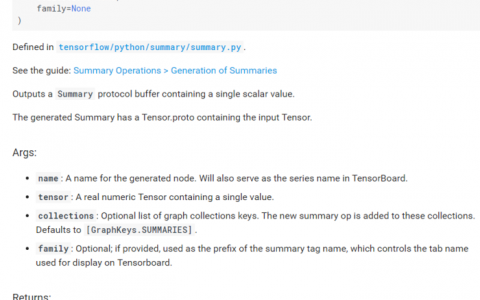TensorFlow 动态获取 BatchSize 的大小实例
在使用 TensorFlow 进行模型训练时,我们通常需要指定 BatchSize 的大小。但是,在实际应用中,我们可能需要动态获取 BatchSize 的大小,以适应不同的数据集。本文将详细讲解如何动态获取 BatchSize 的大小,并提供两个示例说明。
示例1:使用 placeholder 动态获取 BatchSize 的大小
在 TensorFlow 中,我们可以使用 placeholder 动态获取 BatchSize 的大小。具体步骤如下:
- 定义 placeholder 变量,用于存储 BatchSize 的大小。
- 在定义模型时,使用 placeholder 变量作为 BatchSize 的大小。
- 在训练模型时,使用 feed_dict 参数将 BatchSize 的大小传递给 placeholder 变量。
以下是示例代码:
import tensorflow as tf
# 定义 placeholder 变量
batch_size = tf.placeholder(tf.int32, shape=())
# 定义模型
x = tf.placeholder(tf.float32, [None, 784])
y = tf.placeholder(tf.float32, [None, 10])
W = tf.Variable(tf.zeros([784, 10]))
b = tf.Variable(tf.zeros([10]))
y_pred = tf.nn.softmax(tf.matmul(x, W) + b)
# 定义损失函数和优化器
cross_entropy = tf.reduce_mean(-tf.reduce_sum(y * tf.log(y_pred), reduction_indices=[1]))
train_step = tf.train.GradientDescentOptimizer(0.5).minimize(cross_entropy)
# 加载数据集
from tensorflow.examples.tutorials.mnist import input_data
mnist = input_data.read_data_sets("MNIST_data/", one_hot=True)
# 训练模型
with tf.Session() as sess:
sess.run(tf.global_variables_initializer())
for i in range(1000):
batch_xs, batch_ys = mnist.train.next_batch(batch_size.eval(feed_dict={batch_size: 100}))
sess.run(train_step, feed_dict={x: batch_xs, y: batch_ys, batch_size: 100})
在这个示例中,我们首先定义了一个 placeholder 变量 batch_size,用于存储 BatchSize 的大小。然后,我们定义了一个简单的模型,并使用 batch_size 变量作为 BatchSize 的大小。在训练模型时,我们使用 feed_dict 参数将 BatchSize 的大小传递给 batch_size 变量。
示例2:使用 Dataset API 动态获取 BatchSize 的大小
在 TensorFlow 中,我们还可以使用 Dataset API 动态获取 BatchSize 的大小。具体步骤如下:
- 使用 Dataset API 加载数据集。
- 使用 batch() 方法将数据集划分为 Batch。
- 在训练模型时,使用 get_next() 方法获取 Batch,并将 BatchSize 的大小传递给 Dataset API。
以下是示例代码:
import tensorflow as tf
# 使用 Dataset API 加载数据集
dataset = tf.data.Dataset.from_tensor_slices((x_train, y_train))
dataset = dataset.batch(batch_size)
# 定义模型
x = tf.placeholder(tf.float32, [None, 784])
y = tf.placeholder(tf.float32, [None, 10])
W = tf.Variable(tf.zeros([784, 10]))
b = tf.Variable(tf.zeros([10]))
y_pred = tf.nn.softmax(tf.matmul(x, W) + b)
# 定义损失函数和优化器
cross_entropy = tf.reduce_mean(-tf.reduce_sum(y * tf.log(y_pred), reduction_indices=[1]))
train_step = tf.train.GradientDescentOptimizer(0.5).minimize(cross_entropy)
# 训练模型
with tf.Session() as sess:
sess.run(tf.global_variables_initializer())
iterator = dataset.make_initializable_iterator()
next_batch = iterator.get_next()
sess.run(iterator.initializer, feed_dict={batch_size: 100})
for i in range(1000):
batch_xs, batch_ys = sess.run(next_batch)
sess.run(train_step, feed_dict={x: batch_xs, y: batch_ys})
在这个示例中,我们首先使用 Dataset API 加载数据集,并使用 batch() 方法将数据集划分为 Batch。然后,我们定义了一个简单的模型,并在训练模型时,使用 get_next() 方法获取 Batch,并将 BatchSize 的大小传递给 Dataset API。
结语
以上是 TensorFlow 动态获取 BatchSize 的大小实例的详细攻略,包括使用 placeholder 和 Dataset API 两种方法,并提供了两个示例。在实际应用中,我们可以根据具体情况来选择合适的方法,以动态获取 BatchSize 的大小,以适应不同的数据集。
本站文章如无特殊说明,均为本站原创,如若转载,请注明出处:tensorflow 动态获取 BatchSzie 的大小实例 - Python技术站

 微信扫一扫
微信扫一扫  支付宝扫一扫
支付宝扫一扫 

